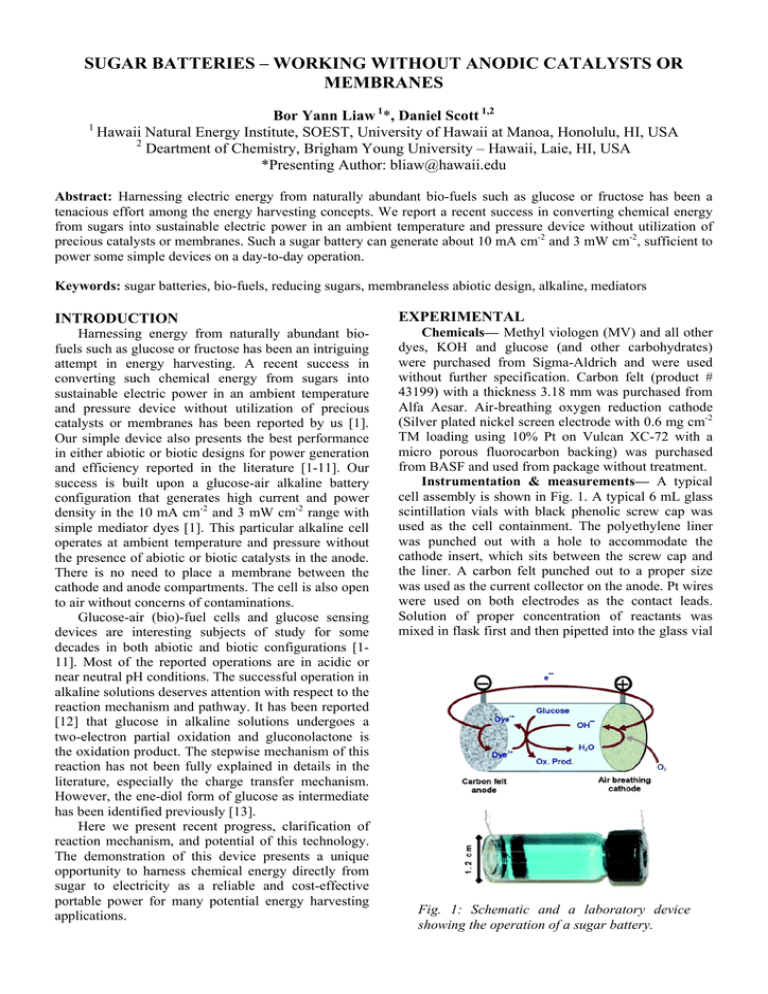SUGAR BATTERIES – WORKING WITHOUT ANODIC CATALYSTS OR MEMBRANES
advertisement

SUGAR BATTERIES – WORKING WITHOUT ANODIC CATALYSTS OR MEMBRANES 1 Bor Yann Liaw 1*, Daniel Scott 1,2 Hawaii Natural Energy Institute, SOEST, University of Hawaii at Manoa, Honolulu, HI, USA 2 Deartment of Chemistry, Brigham Young University – Hawaii, Laie, HI, USA *Presenting Author: bliaw@hawaii.edu Abstract: Harnessing electric energy from naturally abundant bio-fuels such as glucose or fructose has been a tenacious effort among the energy harvesting concepts. We report a recent success in converting chemical energy from sugars into sustainable electric power in an ambient temperature and pressure device without utilization of precious catalysts or membranes. Such a sugar battery can generate about 10 mA cm-2 and 3 mW cm-2, sufficient to power some simple devices on a day-to-day operation. Keywords: sugar batteries, bio-fuels, reducing sugars, membraneless abiotic design, alkaline, mediators INTRODUCTION Harnessing energy from naturally abundant biofuels such as glucose or fructose has been an intriguing attempt in energy harvesting. A recent success in converting such chemical energy from sugars into sustainable electric power in an ambient temperature and pressure device without utilization of precious catalysts or membranes has been reported by us [1]. Our simple device also presents the best performance in either abiotic or biotic designs for power generation and efficiency reported in the literature [1-11]. Our success is built upon a glucose-air alkaline battery configuration that generates high current and power density in the 10 mA cm-2 and 3 mW cm-2 range with simple mediator dyes [1]. This particular alkaline cell operates at ambient temperature and pressure without the presence of abiotic or biotic catalysts in the anode. There is no need to place a membrane between the cathode and anode compartments. The cell is also open to air without concerns of contaminations. Glucose-air (bio)-fuel cells and glucose sensing devices are interesting subjects of study for some decades in both abiotic and biotic configurations [111]. Most of the reported operations are in acidic or near neutral pH conditions. The successful operation in alkaline solutions deserves attention with respect to the reaction mechanism and pathway. It has been reported [12] that glucose in alkaline solutions undergoes a two-electron partial oxidation and gluconolactone is the oxidation product. The stepwise mechanism of this reaction has not been fully explained in details in the literature, especially the charge transfer mechanism. However, the ene-diol form of glucose as intermediate has been identified previously [13]. Here we present recent progress, clarification of reaction mechanism, and potential of this technology. The demonstration of this device presents a unique opportunity to harness chemical energy directly from sugar to electricity as a reliable and cost-effective portable power for many potential energy harvesting applications. EXPERIMENTAL Chemicals— Methyl viologen (MV) and all other dyes, KOH and glucose (and other carbohydrates) were purchased from Sigma-Aldrich and were used without further specification. Carbon felt (product # 43199) with a thickness 3.18 mm was purchased from Alfa Aesar. Air-breathing oxygen reduction cathode (Silver plated nickel screen electrode with 0.6 mg cm-2 TM loading using 10% Pt on Vulcan XC-72 with a micro porous fluorocarbon backing) was purchased from BASF and used from package without treatment. Instrumentation & measurements— A typical cell assembly is shown in Fig. 1. A typical 6 mL glass scintillation vials with black phenolic screw cap was used as the cell containment. The polyethylene liner was punched out with a hole to accommodate the cathode insert, which sits between the screw cap and the liner. A carbon felt punched out to a proper size was used as the current collector on the anode. Pt wires were used on both electrodes as the contact leads. Solution of proper concentration of reactants was mixed in flask first and then pipetted into the glass vial Fig. 1: Schematic and a laboratory device showing the operation of a sugar battery. in desired volume, typically 6 mL, to fill the vial. A Bio-Logic VMP3 multi-channel galvanostatpotentiostat was used to conduct all electrochemical measurements. A typical polarization measurement was conducted by potentiometric method, in which a galvanostatic step was imposed to measure the steady state voltage of the cell. The procedure was repeated until the cell cannot sustain the current and a short circuit current was obtained to complete the entire polarization curve for each solution composition. A typical composition used in the illustration is glucose : KOH : MV = 2 M : 3 M : 28 mM. For durability measurements, a galvanostatic method was used to determine the duration of current sustainability until the cell voltage reach below 0.1 V. Fig. 2: A string of six cells to generate 3.45 V. RESULTS Fig. 2 shows that a sugar alkaline cell with high concentrations of glucose and KOH produced an open circuit voltage (OCV) at about 0.66 V initially. Under galvanostatic mode polarization with potentiometric measurements, we measured stable cell voltages within 10 to 20 min to register a polarization curve as shown. The current density reached above 9 mA cm-2 at which a maximum power of about 2.6 mW cm-2 was achieved at about 0.3 V before a short circuit current was determined at 9.2 mA cm-2. Fig. 3 illustrates that a 6-cell string constructed gives a voltage of 3.45 V almost spontaneously at open circuit. The cell voltage is stable over hours, indicating a reliable operation of the cell is achievable. Fig. 4 shows two sugar alkaline cells with different conditions operated for tens of hours before the glucose level in the solution became too low to sustain the power generation. Fig. 3: The battery can operate over long hours. DISCUSSION The reaction that generates the current and power has been explained [1] as follows: A reducing sugar such as glucose in its reducing form can react with KOH and partially oxidize to its oxidized form of gluconolactone: – – 700 3 600 2.5 500 2 400 1.5 300 1 200 0.5 100 0 Power Density (mW/cm2 ) . Cell Voltage (mV) C6H12O6 + 2 OH C6H10O6 + 2 H2O + 2 e 0 0 2 4 6 2 8 10 Current Density, i (mA/cm ) Fig. 4: A power generation and corresponding V-I curve for a sugar battery with 2 M glucose, 3 M KOH, and 28 mM methyl viologen. (1) The reaction intermediate has been reported to be an ene-diol form [13], which reacts with mediator such as methyl viologen (MV) to transfer electrons: – 2 MV+2 + 2 e 2 MV+y (2) A shuttle process known to mediator that can assist electron transfer to electrode surface thus facilitates the current generation at the anode (negative electrode): – 2 MV+y 2 MV+2 + 2 e (3) On the cathode side (positive electrode) a typical oxygen reduction reaction (ORR) occurs: – – O2 + 2 H2O + 4 e 4 OH The overall cell reaction is therefore, (4) 2 C6H12O6 + O2 2 C6H10O6 + 2 H2O (5) An interesting aspect of this cell reaction is its unconventional pathway that the oxidation of glucose takes place in the solution with charge transfer to the mediator. The reaction on the anode surface is actually the re-oxidation of viologen mediator. The polarization and power curves shown in Fig. 2 are typical performance characteristics of a glucose-air alkaline cell; in this case, a rather high concentration of glucose (2 M) was used. So is KOH. The resulting current and power density are quite high; higher than any biotic or abiotic cell designs we know to date in the literature at room temperature and pressure. As we explained in Ref [1], the current and power density are in proportion with glucose concentration. Without the presence of glucose, the KOH/VM solution is not capable of producing any measurable current. It is thus evident that glucose was the reactant that powers the cell operation. The current and power densities also vary with mediator concentration. Without mediator, the glucose/KOH solution cannot produce current or power. However, different from glucose, the mediator is known to shuttle electrons, not acting as the source of energy. It is worth noting that the mediator is not serving as a catalyst, since there is no evidence that the kinetics of the glucose oxidation is promoted. On the other hand, the electron transfer is achieved due to the shuttle mechanism of the mediator, which changes the mass balance of the reaction equilibrium as depicted by the Le Châtelier’s principle. What this entails is that the mediator alters the equilibrium balance among the reactants and intermediate – glucose, KOH, and enediol. As the shuttling mechanism takes place in the solution between the mediator and the ene-diol that allows the electron transfer, a tendency to restore the equilibrium among glucose, hydroxide, and ene-diol remains, as depicted by the Le Chatelier’s principle. Such oxidation-mediation continues until the reaction is not sustainable at a certain rate. With understanding of this mechanism, we further identify that the reaction rate determine step is due to the transport of the mediator to the carbon felt, which induces the limiting current. Such an interpretation is supported by the polarization behavior and power generation profile illustrated in Fig. 2. The immediate fall off to short circuit condition from maximum power generation is indicative that the reaction has reached the limiting current and cannot sustain mass transport. CONCLUSION An approach to harvest chemical energy in sugars such as glucose (and other reducing sugars) to generate power is demonstrated in this work. This approach has the potential of generating power density above tens of mW cm-2. The cell operates at room temperature and pressure in a quiescent mode. The performance is one of the best so far in all abiotic and biotic designs in the literature. The reaction mechanism is based on a partial oxidation of glucose to gluconolactone in alkaline solution with ene-diol as intermediate. The reaction of ene-diol and mediator such as methyl viologen allows effective charge transfer, and under a shuttle process, promotes the current and power generation. ACKNOWLEDGEMENTS This work was supported under the Intelligence Community Postdoctoral Fellow Research Program (Project: Nano- and Micro-Enzymatic Power Sources, HM1582-04-1-2013). REFERENCES [1] [2] [3] [4] Scott D, Liaw B Y 2009 Harnessing electric power from sugar ― an inexpensive carbohydrate-oxygen alkaline fuel cell mediated by redox dyes Energy Environ. Sci. 2 965–969. Kerzenmacher S, Ducrée J, Zengerle R, von Stetten F 2008 Energy harvesting by implantable abiotically catalyzed glucose fuel cells J. Power Sources 182 1– 17. Allen R M, Bennetto H P 1993 Microbial fuel cells: electricity production from carbohydrates Microbial fuel cells: electricity production from carbohydrates Appl. Biochem. Biotechnol. 39/40 27–40. Chaudhuri S K, Lovley D R 2003 Electricity generation by direct oxidation of glucose in mediatorless microbial fuel cells Nature Biotech. 21 [5] [6] 1229–1232. Logan B E, Aelterman P, Hamelers B, Rozendal R, Schröder U, Keller J, Freguia S, Verstraete W, Rabaey K 2006 Microbial fuel cells: Methodology and technology Environ. Sci. Technol. 9 5181– 5192. Topcagic S, Minteer S D 2007 Development of a membraneless [7] [8] [9] ethanol/oxygen biofuel cell Electrochim. Acta 51 2168–2172. Chen T, Barton S C, Binyamin G, Gao Z, Zhang Y, Kim H-H, Heller A 2001 A miniature biofuel cell J. Am. Chem. Soc. 123 8630–8631. Katz E, Shipway A N, Willner I 2003 Biochemical fuel cells in Handbook of Fuel CellsFundamentals, Technology, Applications (eds. Vielstich W, Gasteiger A, Lamm A), Vol. 1(4), Ch. 21 355–381 (Chichester, PA, John Wiley & Sons). Barton S C, Gallaway J, Atanassov P 2004 Enzymatic biofuel cells for implantable and microscale devices Chem. Rev. 104 4867–4886. [10] Minteer S D, Liaw B Y, Cooney M J 2007 Enzyme-based biofuel cells Current Opinion in Biotechnology 18 228–234. [11] Sakai H, Nakagawa T, Tokita Y, Hatazawa T, Ikeda T, Tsujimura S, Kano K 2009 A high-power glucose/oxygen biofuel cell operating under quiescent conditions Energy & Environ. Sci. 2 133–138. [12] Aoun S B, Bang G S, Koga T, Nonaka Y, Sotomura T, Taniguchi I 2003 Electrocatalytic oxidation of sugars on silver-UPD single crystal gold electrodes in alkaline solutions Electrochem. Comm. 5 317–320. [13] Itoh S, Mure M, Ohshiro Y 1987 Oxidation of Dglucose by coenzyme PQQ. 1,2-Enediolates as substrates for PQQ oxidation J. Chem. Soc., Chem. Comm. 20 1580–1581.



